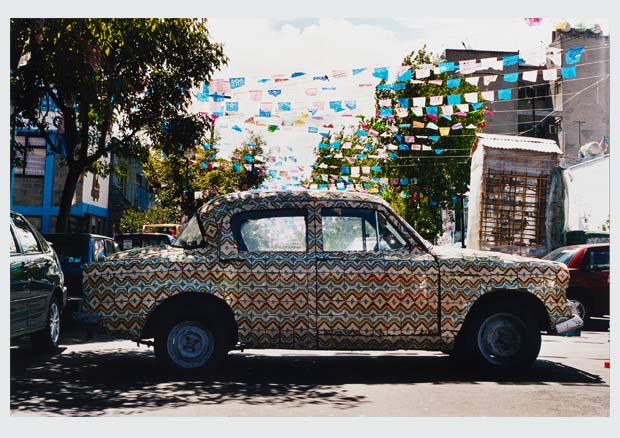Without Restraint Works by Mexican Women Artists from the Daros Latinamerica Collection
Without Restraint presents together for the first time contemporary Mexican art by women from the Daros Latinamerica Collection (Zurich), Europe’s largest and most important collection of its kind. Seven women artists who live and work in Mexico show their lifeworld from a decidedly female point of view and respond to international artistic movements with very different approaches.
In Without Restraint 35 works including photographs, videos, objects, and installations by the following internationally acclaimed women artists are exhibited: Ximena Cuevas (*1963), Claudia Fernández (*1965), Teresa Margolles (*1963), Betsabeé Romero (*1963), Maruch Sántiz Gómez (*1975), Teresa Serrano (*1936) and Melanie Smith (*1965).
These multifaceted and thought-provoking works provide an overview of the most characteristic features of the Mexican contemporary art scene and of its development in recent decades. At the same time, the exhibition offers the opportunity to critically reflect upon and contextualize women artists’ production in contemporary Mexico. The works of these seven artists engage with the concept of mexicanidad — of Mexican national identity — and challenge the traditional roles and social spaces assigned to women and to minorities by the dominant hierarchies of power. By using different medias, these artists overthrow the existing order of everyday life and routine which traps women in a labyrinth of traditional archetypes. Topics such as life and death, the violated body, identity and migration, nature and the metropolis are critically examined and discussed in their works.
Women Artists in Mexico
In the first half of the twentieth century, national art institutions and academies throughout Latin America were often not accessible to women, and women’s participation in the arts was long limited to the field of popular and folk arts and crafts, that is, to “hobbies” which were considered compatible with domestic work. Mexican art schools and academies, such as the prestigious San Carlos and La Esmeralda, continued to remain stagnant centers of male chauvinism and patriarchal aesthetics well into the nineteen-sixties and seventies. Topics such as female sexuality, subjectivity, and everyday life were regarded with scorn and ridiculed by the male dominant majority, or even disallowed. Despite this marginalization, Mexican art witnessed notable contributions to modernism by extremely talented women artists like Leonora Carrington, Maria Izquierdo, Tina Modotti, Remedios Varo, and the undeniably best known of them all, Frida Kahlo.
It was only during the nineteen-seventies that feminist art emerged in Latin America and within the Latina communities in the United States, Canada, and Europe. The first artists’ group to be explicitly feminist and to reflect on a set of gender issues like discrimination, violence, and stereotyping motherhood was the collective Polvo de Gallina Negra (Black Hen’s Powder) created in 1983 by artists Maris Bustamante and Mónica Mayer.
Despite the fact that in the past thirty years opportunities have increased for women artists to study, work, and exhibit, even nowadays in Mexico it is quite exceptional that art by women is exhibited solo or within thematically coherent all-women exhibitions in museums or galleries. Feminist art has not been given adequate attention by Mexican and international critics and the word «feminism» is still stigmatized.
The majority of women artists do not wish to recognize themselves or their art as necessarily “feminist”, out of fear of being boycotted by institutional prejudice and by the establishment. Their work, however, shares the same desire to subvert stereotypes of womanhood, race, and sexual identity—and, in this sense, is a vehicle of dissent from Mexican patriarchy.
Objectives and Structure of the Exhibition
Giving space and voice to what in Mexico is still a neglected minority within the art establishment, Without Restraint seeks to dismiss some of the stereotypes upon which rests the exoticized and hybrid image of “authentically” Mexican art by women that is still so often encountered in the Western world. The works in the exhibition are arranged both by artist and thematically, following a tripartition centred on the active production of space and on the artists’ effort to inform new social relations and subvert traditional hierarchies of power and gender roles: 1) the domestic space of the home; 2) the spatial female body; 3) the urban space.
70 Years of Diplomatic Relations Between Switzerland and Mexico
Without Restraint is under the patronage of H.E. Ms. Claudia Ruíz Massieu Salinas, the Mexican Secretary of Foreign Affairs, and Swiss Federal Councillor H.E. Mr. Didier Burkhalter, Head of the Federal Department of Foreign Affairs (FDFA). It coincides with celebrations to mark the seventieth anniversary of diplomatic relations between Switzerland and Mexico and has been realized in close cooperation with the Federal Department of Foreign Affairs and the Embassy of Mexico in Switzerland. Without Restraint is made possible in part by the artEdu Foundation, the Prof. Otto Beisheim Foundation, and by private and anonymous donors. The Zurich Insurance Company Ltd. is generously supporting this exhibition.
Curator: Dr. Valentina Locatelli
Contact person:
Maria-Teresa Cano, Head of Department Communications and Art mediation, , Tel.: +41 31 359 01 89


